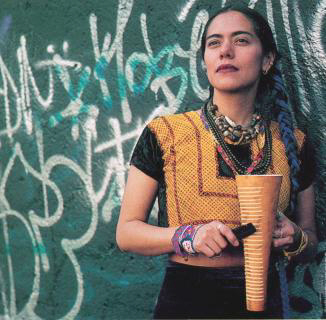
You have a new album coming out at the end of the summer titled Shake Away. Tell us about the project and the songs included in the album.
The project consists mainly of original music and compositions that have to do with the themes of healing and social consciousness. Shake Away, Shake Away, All The Many Sorrows.
What led you to compose the song "Minimum Wage"?
Basically the backbone of this country consists of the workers, many of whom are immigrants, legals and illegals, all for the minimum wage…
You invited leading female singers Mercedes Sosa, Chambao’s La Mari to perform in Shake Away. Why these charismatic figures?
Mercedes Sosa of course is an icon, one of the major voices in the history of Latin music, I’ve always admired her voice and message. La Mari is an amazing woman and flamenco singer who is also doing a fusion of roots music with modern elements.
Now let’s get back to your roots. How was life in La Mixteca, in Oaxaca?
It’s a small market town surrounded by many indigenous communities, it has a lot of beauty as well as much social and economic tensions.
What kind of music did you listen to?
Everything from opera to jazz to ranchera

I always moved back and forth as a child, my university experience was about studying opera and also opening up to the alternative worlds and lifestyles, I finished my degree in voice and cultural anthropology.
You performed at restaurants and bars in the villages of Oaxaca. What kind of repertoire did you sing?
A mixture of Oaxacan songs, like "La Llorona," "La Sandunga," and also jazz standards like "My One and Only Love" and "My Funny Valentine."
I read that your mother wasn’t very happy to see you sing at restaurants and bars. Why was that?
Due to necessity she needed to sing at cafes and restaurants to get by when she went as a teenager to mexico city, so she didn’t want me to repeat that kind of life.
When did you decide to become a professional singer?
I returned from college to work in my mother’s car parts store in the Mixtec mountains, and I started singing popular music in a traditional brass band, then I started singing with folk bands and finally in a little trio in club called "El Sol y La Luna" in Oaxaca.
You cite John Coltrane as major influence on your music. Can you elaborate on that?
His spirit and sound revolutionized music, he was always looking to express a truth from the inside.
In some interviews you have been quoted as saying that you are surprised that your music has become internationally successful. Why do you think you are having such success?
We basically are working and touring musicians, and we have had the fortune to be able to perform our beliefs. We are fortunate that many people around the world relate to our music.
Were you expecting to win a Latin Grammy?
No, but very happy with it.
You now live in New York, far from Mexico. How is that affecting your music?
We live in Mexico City, Oaxaca, and in New York, and of course a lot on the road. New York is a constantly changing city with all kinds of diversity, but of course I miss the serenity and the strength of the indigenous world of southern Mexico as well.
Do you miss Mexico?
Mucho, mucho
Is your music popular in Mexico?
More and more, this is something I am very proud of.

Martirio came to see us perform a couple of years ago in Madrid and we created a friendship. She is a great artist and we collaborate in a special way.
I’ve seen a recent poster of you with Martirio and both of you wear colorful hair styles and brightly colored traditional clothes.
We both are very proud of our roots, and we are trying to renovate them at the same time.
You participated in the Salma Hayak’s movie Frida as singer and actress How did you get involved with the movie?
Julie Taymor, the director, and Elliot Goldenthal, the composer, discovered our cds in the music store, and came to see us perform in Mexico city. They invited me to sing in the soundtrack and in the movie.
Have you done any more acting since then?
Not really.
Which is your favorite Mexican musical instrument?
Maybe la quijada (which is the jawbone of the burro played in Veracruzan music). There are so many amazing instruments in Mexico, from the harp to las jaranas and el guitarrón.
What’s next in your agenda, aside from promoting the new album?
Looking forward to performing the new songs and writing new things.
Buy the CD:
- In North America: Shake Away. Other CDs available: Lila Downs y La Misteriosa en Paris – Live a FIP, Border (La Linea), La Cantina, La Sandunga, Una Sangre (One Blood), Tree of Life, The Very Best Of
- In Europe: Shake Away. Other CDs available: Lila Downs y La Misteriosa En Paris: Live a Fip, The Very Best of Lila Downs, Border – La Linea, Una Sangre, La Cantina: Entre Copa y Copa, La Sandunga, Tree of Life
Author: Angel Romero
Angel Romero y Ruiz has dedicated his life to musical exploration. His efforts included the creation of two online portals, worldmusiccentral.org and musicasdelmundo.com. In addition, Angel is the co-founder of the Transglobal World Music Chart, a panel of world music DJs and writers that celebrates global sounds. Furthermore, he delved into the record business, producing world music studio albums and compilations. His works have appeared on Alula Records, Ellipsis Arts, Indígena Records and Music of the World.


